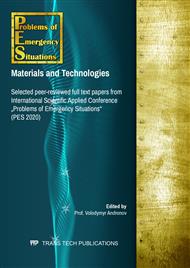[1]
Al.Al. Berlin Gorenie polimerov i polimernyie materialyi ponizhennoy goryuchesti, Sorovskiy obrazovatelnyiy zhurnal. 9 (1996) 57-63 [in Russian].
Google Scholar
[2]
A. Vasilchenko, Y. Otrosh, N. Adamenko, E. Doronin, A. Kovaliov, Feature of fire resistance calculation of steel designs with intumescent coating, MATEC Web of Conferences 230 (2018) 02036.
DOI: 10.1051/matecconf/201823002036
Google Scholar
[3]
V.F. Kablov, O.M. Novopoltseva, V.G. Kochetkov et al., Elastomer Heat-Shielding Materials Containing Aluminosilicate Microspheres, Russ. Engin. Res. 37 (2017) 1059–1061.
DOI: 10.3103/s1068798x17120085
Google Scholar
[4]
S. Nie, S. Qi, M. He et al., Synergistic effects of zeolites on a novel intumescent flame-retardant low-density polyethylene (LDPE) system, J Therm Anal Calorim. 114 (2013) 581–587.
DOI: 10.1007/s10973-013-3011-9
Google Scholar
[5]
Yu.A. Mihaylin, Teplo-, termo- i ognestoykost polimernyih materialov, NOT Sankt-Peterburg, 2011 [in Russian].
Google Scholar
[6]
M. Zhi, Q. Liu, H. Chen, X. Chen, S. Feng, Y. He, Thermal Stability and Flame Retardancy Properties of Epoxy Resin Modified with Functionalized Graphene Oxide Containing Phosphorus and Silicon Elements, ACS Omega. 4(6) (2019) 10975-10984.
DOI: 10.1021/acsomega.9b00852
Google Scholar
[7]
L. Li, X. Shao, Z. Zhao, X. Liu, L. Jiang, K. Huang, S. Zhao, Synergistic Fire Hazard Effect of a Multifunctional Flame Retardant in Building Insulation Expandable Polystyrene through a Simple Surface-Coating Method, ACS Omega. 5(1) (2020) 799-807.
DOI: 10.1021/acsomega.9b03541
Google Scholar
[8]
Mingzhe Dong, Xiaoyu Gu, Sheng Zhang,Hongfei Li, Peng, Jiang Effects of Acidic Sites in HA Zeolite on the Fire Performance of Polystyrene Composite, Ind. Eng. Chem. Res., 52(26) (2013) 9145-9154.
DOI: 10.1021/ie4011222
Google Scholar
[9]
J.P. Hos, P.G. Mccormick, L.T. Byrne, Investigation of a synthetic aluminosilicate inorganic polymer, Journal of Materials Science. 37 (2002) 2311–2316.
Google Scholar
[10]
D. Brek, Tseolitovyie molekulyarnyie sita, Mir, 1976 [in Russian].
Google Scholar
[11]
I.D. Kashcheev, K.G. Zemlyanoi, K.O. Stepanova, Possibility of Preparing Aluminosilicate Fillers Based on Kaolin and Technogenic Materials, Refractories and Industrial Ceramics. 58(5) (2018) 566-572.
DOI: 10.1007/s11148-018-0146-z
Google Scholar
[12]
P.A. Sitnikov, A.V. Kuchin, A.G. Belykh et al. Preparation of epoxy composite material containing natural aluminosilicate filler, Polym. Sci. Ser. D 4 (2011) 281–283.
DOI: 10.1134/s1995421211040125
Google Scholar
[13]
Yang Zhao, Dietmar Drummer, Influence of Filler Content and Filler Size on the Curing Kinetics of an Epoxy Resin, Polymers. 11(11), (2019) 1797.
DOI: 10.3390/polym11111797
Google Scholar
[14]
DSTU EN ISO 4589-3:2018 (EN ISO 4589-3:2017, IDT; ISO 4589-3:2017, IDT) Plastmasi. Viznachennya harakteristik gorinnya za kisnevim indeksom. Chastina 3. Viprobuvannya za pidvischenoyi temperaturi [in Ukrainian].
Google Scholar
[15]
Edward D. Weil, Sergei Levchik, A Review of Current Flame Retardant Systems for Epoxy Resins, Journal of Fire Sciences. 22(1) (2004) 25-40.
DOI: 10.1177/0734904104038107
Google Scholar
[16]
Alex A. Lyapkov, Nelly M. Rovkina, Producing polymers by the polymerization techniques Editor: prof., M.S. Usubov, Publisher of Tomsk Polytechnic University, (2015).
Google Scholar
[17]
A.S. Panshin i dr., Vliyanie antipirenov na goryuchest polietilena, Plasticheskie massyi. 1 (1974) 40-43 [in Russian].
Google Scholar
[18]
Tiurlina Siregar, Bambang Ari Wahjoedi, Sentani Natural Zeolite as a Filler for Polyethylene Composite, International Journal of Scientific and Research Publications. 5(1) (2015) 2250-3153.
Google Scholar
[19]
DSTU EN ISO 527-2:2018, Plastmasi. Viznachennya vlastivostey pid chas roztyaguvannya. Chastina 2. Umovi viprobuvannya dlya plastmas, vigotovlenih metodom formuvannya ta ekstruziyi (EN ISO 527-2:2012, IDT; ISO 527-2:2012, IDT) [in Ukrainian].
Google Scholar
[20]
DSTU B N EN 1991-1-2:2010 Diyi na konstruktsiyi. Chastina 1-2. ZagalnI diyi. Diyi na konstruktsiyi pId chas pozhezhI (EN 1991-1-2:2002, IDT) [in Ukrainian].
Google Scholar
[21]
B. Samujło, Effects of the flame retardant and lubricant types on fire retardancy effectiveness of medium density polyethylene, Polimery-Warsaw. 49(3) (2004) 191-194.
DOI: 10.14314/polimery.2004.191
Google Scholar


